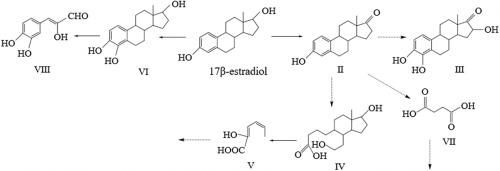Journal of Hazardous Materials ( IF 12.2 ) Pub Date : 2021-09-11 , DOI: 10.1016/j.jhazmat.2021.127185 Qu Zhang 1 , Chao Xue 1 , Gary Owens 2 , Zuliang Chen 1

|
The widespread presence of 17β-estradiol (E2) in the environment is an emerging problem because it poses a potential threat to human health and aquatic organisms. In this study, a strain of E2 degrading bacteria was isolated from activated sludge. 16s rRNA analysis combined with physiological and biochemical detection confirmed that the bacterium was Ochrobactrum sp. strain FJ1. At an initial E2 concentration of 15 mg L−1, strain FJ1 degraded 98 ± 1% of E2 after 10 days. Furthermore, when methanol was added as an additional carbon source, the biomass of strain FJ1 increased by 35 ± 1%, and E2 degradation efficiency was slightly inhibited. Compared with E2 alone when glucose, sodium acetate, and methanol were added as additional carbon sources, biomass decreased by 20 ± 1, 13 ± 1 and 35 ± 1%, respectively. Analysis of the degradation products of E2 by LC/Q-TOF-MS confirmed that the major degradation products of E2 were estrone (E1) and 4,16-OH-E1, which was further degraded by strain FJ1 to several other unknown compounds. Based on SEM and FTIR analysis, the morphology of the bacteria became thicker and the thickness of the cell walls decreased under initial E2 stress, and thereafter E2 was transported into the bacteria primarily via several proteins on the cell surface. Considering the ability and efficiency of Ochrobactrum sp. strain FJ1 to degrade high E2 content, the strain could provide a new bioremediation technology for the effective biodegradation of E2. Finally, a potential bioremediation pathway of E2 by Ochrobactrum sp. strain FJ1 was proposed.
中文翻译:

17β-雌二醇降解菌的分离鉴定及其降解途径
17β-雌二醇 (E2) 在环境中的广泛存在是一个新出现的问题,因为它对人类健康和水生生物构成潜在威胁。在这项研究中,从活性污泥中分离出一株 E2 降解菌。16s rRNA分析结合生理生化检测证实该菌为Ochrobactrum sp。菌株 FJ1。初始 E2 浓度为 15 mg L -1,菌株 FJ1 在 10 天后降解了 98 ± 1% 的 E2。此外,当添加甲醇作为额外的碳源时,菌株 FJ1 的生物量增加了 35 ± 1%,并且对 E2 的降解效率略有抑制。与单独添加葡萄糖、乙酸钠和甲醇作为额外碳源时的 E2 相比,生物量分别减少了 20 ± 1、13 ± 1 和 35 ± 1%。LC/Q-TOF-MS对E2降解产物的分析证实,E2的主要降解产物是雌酮(E1)和4,16-OH-E1,它们被FJ1菌株进一步降解为其他几种未知化合物。基于 SEM 和 FTIR 分析,在初始 E2 应力下,细菌形态变厚,细胞壁厚度减小,此后,E2 主要通过细胞表面的几种蛋白质转运到细菌中。考虑到能力和效率Ochrobactrum sp。菌株FJ1降解高E2含量,该菌株可为E2的有效生物降解提供一种新的生物修复技术。最后,Ochrobactrum sp对E2的潜在生物修复途径。提出了菌株FJ1。











































 京公网安备 11010802027423号
京公网安备 11010802027423号